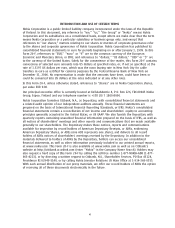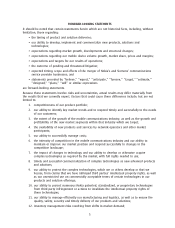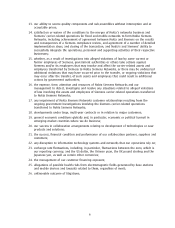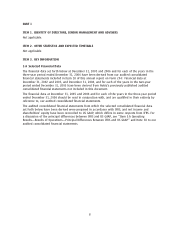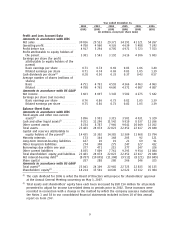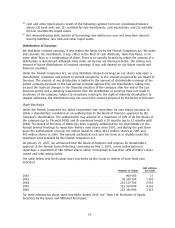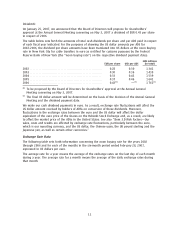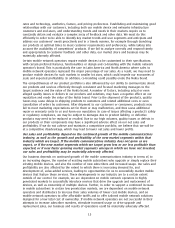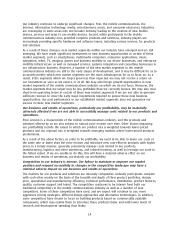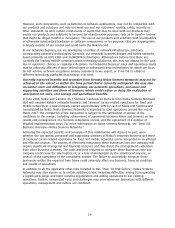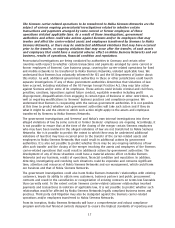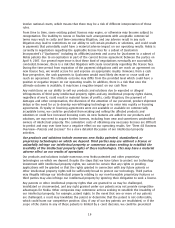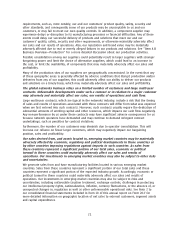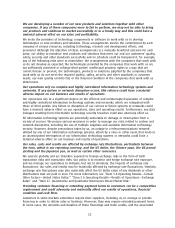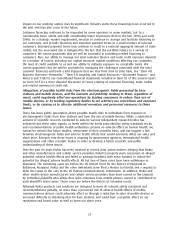Nokia 2006 Annual Report Download - page 14
Download and view the complete annual report
Please find page 14 of the 2006 Nokia annual report below. You can navigate through the pages in the report by either clicking on the pages listed below, or by using the keyword search tool below to find specific information within the annual report.rates and technology, aesthetics, feature, and pricing preferences. Establishing and maintaining good
relationships with our customers, including both our mobile device and networks infrastructure
customers and endusers, and understanding trends and needs in their markets require us to
constantly obtain and evaluate a complex array of feedback and other data. We must do this
efficiently in order to be able to identify key market trends and user segments and anticipate and
address our customers’ needs proactively and in a timely manner, for example through launching
our products at optimal times to meet customer requirements and preferences, while taking into
account the availability of competitors’ products. If we fail to analyze correctly and respond timely
and appropriately to customer feedback and other data, our market share and business may be
materially adversely affected.
Certain mobile network operators require mobile devices to be customized to their specifications
with certain preferred features, functionalities or design and cobranding with the mobile network
operator’s brand. This is particularly the case in Latin America and North America where sales to
mobile network operators represent the major percentage of our sales. As a result, we may need to
produce mobile devices for such markets in smaller lot sizes, which could impede our economies of
scale and expected profitability. In addition, cobranding could possibly erode the Nokia brand.
The competitiveness of our product portfolio is also influenced by our ability to communicate about
our products and services effectively through consistent and focused marketing messages to the
target audience and the value of the Nokia brand. A number of factors, including actual or even
alleged quality issues or defects in our products and solutions, may have a negative effect on our
reputation and erode the value of the Nokia brand. Prior to the shipment of the products, quality
issues may cause delays in shipping products to customers and related additional costs or even
cancellation of orders by customers. After shipment to our customers or consumers, products may
fail to meet marketing expectations set for them or may malfunction, and thus cause additional
repair or warranty costs to us and harm our reputation. In case of issues affecting a product’s safety
or regulatory compliance, we may be subject to damages due to product liability, or defective
products may need to be replaced or recalled. Due to our high volumes, quality issues or defects in
our products or their components may have a significant adverse effect on our net sales and
profitability. If we do not achieve and maintain a competitive portfolio, we believe that we will be
at a competitive disadvantage, which may lead to lower net sales and lower profits.
Our sales and profitability depend on the continued growth of the mobile communications
industry, as well as the growth and profitability of the new market segments within that
industry which we target. If the mobile communications industry does not grow as we
expect, or if the new market segments which we target grow less or are less profitable than
expected, or if new faster growing market segments emerge in which we have not invested,
our sales and profitability may be materially adversely affected.
Our business depends on continued growth of the mobile communications industry in terms of, to
an increasing degree, the number of existing mobile subscribers who upgrade or simply replace their
existing mobile devices, and also the number of new subscribers and increased usage. Our sales and
profitability are also affected by the extent to which there is increasing demand for, and
development of, valueadded services, leading to opportunities for us to successfully market mobile
devices that feature those services. These developments in our industry are to a certain extent
outside of our control. For example, we are dependent on mobile network operators in highly
penetrated markets to successfully introduce services that drive the upgrade and replacement of
devices, as well as ownership of multiple devices. Further, in order to support a continued increase
in mobile subscribers in certain low penetration markets, we are dependent on mobile network
operators and distributors to increase their sales volumes of lower cost mobile devices, and on
mobile network operators to offer affordable tariffs and to offer tailored mobile network solutions
designed for a low total cost of ownership. If mobile network operators are not successful in their
attempts to increase subscriber numbers, stimulate increased usage or drive upgrade and
replacement sales, our business and results of operations could be materially adversely affected.
13



